A single sentence in Redemption Tidings 13 January 1961 (p. 10) sheds a little light on the probable origins of the first pentecostal assembly in Oxford. C. L. Parker, who later taught in the Assemblies of God bible school in Hampstead and Kenley, spent 1922 and 1923 in a ‘pioneering attempt’ in Oxford, and succeeded in raising a small assembly:

The August 1925 edition of Redemption Tidings, a monthly publication of the Assemblies of God:

contained (p. 16) lists of 55 assemblies in England and Ireland, and 44 in Wales and Monmouthshire, that were in fellowship with the AoG as of 30 July 1925, along with the names of the Presbyter (ie elder) of each one. There was an assembly in Oxford, and F. Major was the presbyter:
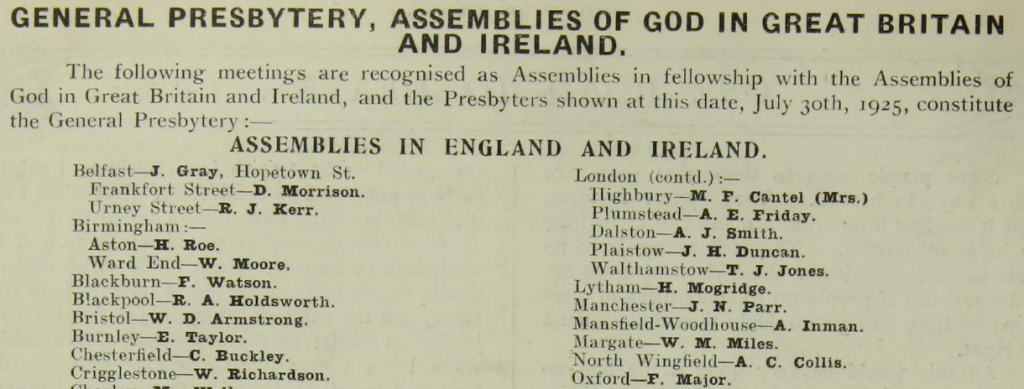
1924-26: ‘such a terrible hard place’
The November 1925 edition contained a plea to all the assemblies to pray for Oxford in particular:

Mr. Major, here referred to as the pastor, was having ‘a very hard time’, and Oxford was described as a ‘terrible hard place’. Only Almighty God could give the needed breakthrough.
It appears from a later comment from Marguerite Major (see below) that she and her husband had been labouring there since 1924. There was thus perhaps a short gap between C. L. Parker’s departure in 1923 and the Majors’ arrival the next year.
Progress came in an unexpected way in February 1926, not in Oxford but in Ramsgate, Kent, during a revival and divine healing campaign conducted by Stephen Jeffreys (RT March 1926, p. 6):

A lady from Oxford received a wonderful healing at the campaign, and her sister then visited and testified that ‘the whole of Oxford was stirred’ by what God had done:

A letter from the pastor appeared in the May 1926 edition (p. 8), asking for prayer, thanking God for the provision of a Gospel Car, and apparently giving other assemblies the opportunity to share in the work through financial support of the associated expenses. Oxford is described as ‘very hard’:
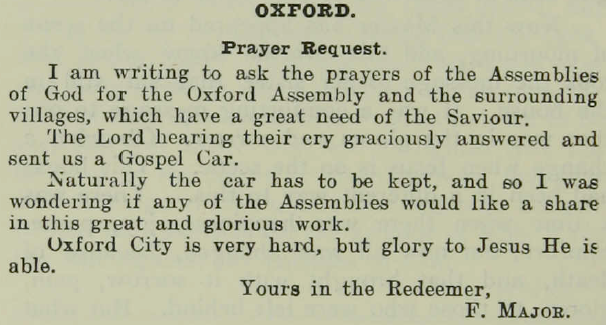
July 1926: ‘the hard ground has been broken’
Deliverance came in July the same year through a six day revival campaign conducted by four young men from the Hampstead Bible and Missionary Training School. It had seemed, wrote Marguerite E. Major, presumably the pastor’s wife, that nothing could be done in Oxford, and the previous two years (giving us our date of 1924 for their arrival) had been ‘almost heart-breaking’:
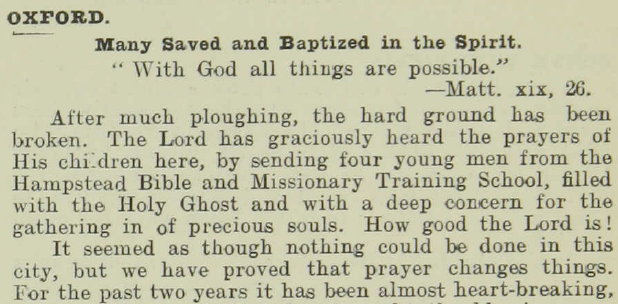
but God had given the victory through wrestling in prayer. The meetings were held in Pembroke Hall, which was almost certainly (see below) just off the Cowley Road, in what is now Rectory Road. Attendance averaged forty in the evenings. Twenty-eight young people confessed Christ publicly, and four were baptised in the Holy Spirit with the evidence of speaking in other tongues:
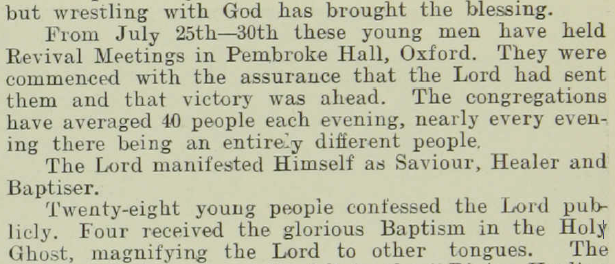
A divine healing service was held on the Thursday afternoon (29 July), attracting the largest attendance yet seen by the assembly. A lady walked for the first time in seven years, to the glory of Jesus! There was a hunger for the baptism of the Holy Spirit with Christians visiting from other churches to seek that blessing:

The young evangelists had travelled in a Gospel Car, with which they had visited surrounding villages. They were on their way to Wales. ‘Pray for us’ was Marguerite Major’s closing plea, ‘that the work of the Lord will be established in this place’. All the glory was to God:

The connection with Ramsgate was maintained (RT February 1927, p. 8) through a visit by brother and sister Major in October 1926 to minister there at the opening of their first hall:
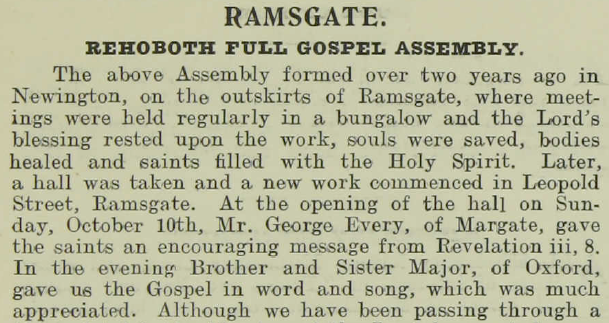
The end of the year saw (RT December 1926, p. 20) a three day convention at Pembroke Hall with ministry from a Mr C Hartwright, again from the Hampstead training school:

We learn from this notice that Pembroke Hall was in Pembroke Street off Cowley Road. A map from 1939 shows a hall that fits the description, being only about sixty yards from Cowley Road:
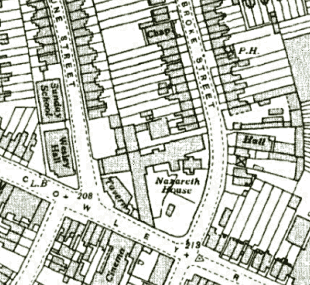
Pembroke Street became Rectory Road in the 1950s:
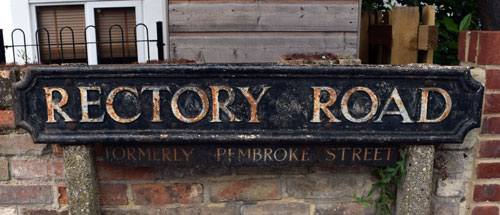
1927: a new pastor
A notice (RT June 1927, p. 15) for a five day convention to be held from 12 to 16 June 1927 reveals that the Oxford assembly by then had a new pastor, James Mothersole:

According to Mothersole’s report of the convention (RT July 1927, p. 9), the ‘little hall’ was almost filled on the Sunday evening (12 June):
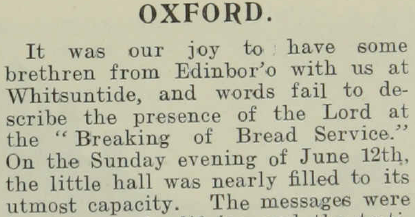
The sick were prayed for, with anointing of oil:
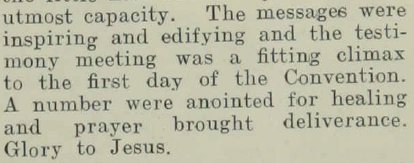
Tuesday brought an exhortation to heed the Lord Jesus’s instruction to enter into our closets to pray to our Heavenly Father in secret, shutting the door behind us (Matthew 6:6):

Like his predecessor, brother Mothersole appealed for prayer for Oxford, specifically for a mighty outpouring of the Holy Spirit upon the city:

The venue, 45 Broad Street, was at that time a private home occupied by a Frederick Cutliffe, a ‘teacher in the English language’ and family:
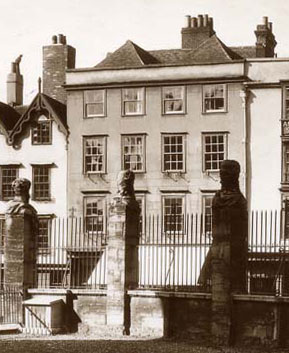
As of 1911, there were at least 18 rooms in the house. As of 1921, Cutliffe and his wife had seven children, six boarders and three servants resident in the house. Presumably there was a large room that could be described as a ‘little hall’. The whole property, at the time of its demolition in 1936-37, extended (p. 172) back about 160 feet (the hatched buildings are additions later than the mid eighteenth century). The rooms marked A and B (on four floors) were about 20 feet long. On the ground floor level, they were occupied by a post office from 1921-35, but there were three stories above. The larger room E had been subdivided by this time, according to Pantin (‘The Recently Demolished Houses in Broad Street’ Oxoniensa 1937, p. 187).
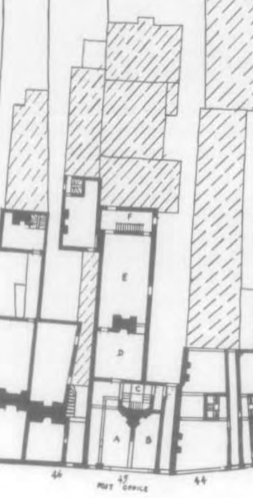
The buildings at the back are contenders for our ‘little hall’, but part of the property was occupied from 1921-28 by the Oxford Secretarial & Typewriting Bureau. Perhaps one or more of the residents were members of the assembly.
A Mr H. Mothersole is listed (RT July 1927, p. 15) as the presbyter as of 30 June 1927:

Since James Mothersole was the pastor at that time (see above), the initial is perhaps in error.
1928-53: Miss Weightman leads the assembly
Just one year later, as of 30 June 1928, a Miss Weightman is listed as the presbyter:

An advert in Redemption Tidings of June 1929 (p. 19) shows that the assembly was meeting near Glebe St:

which is near what is now Rectory Road:
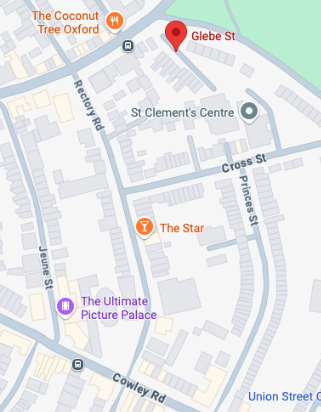
and was then Pembroke Street, raising the possibility that the assembly was again in Pembroke Hall. In December 1930, Miss Weightman is said (p. 14) to be ‘continuing’ as leader of the assembly:

possibly with the implication that she had originally accepted the position with some reluctance or on a temporary basis. She is still listed as presbyter as of 1 January 1933 (RT February 1933, p. 20):

and was in fact to continue as leader until 1953.
Healing testimonies
In the December 1931 edition of Redemption Tidings, a Mrs Madeline Reeves:

in her testimony of two remarkable healings, the first of which had taken place in New Zealand in 1925, said (p. 16) that she had sent to ‘the Mission Hall’ to be anointed with oil for healing by the elders according to James 5:14, after being run down by a car and breaking her leg:
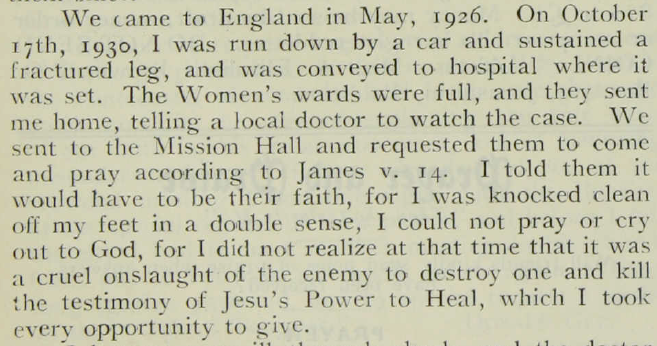
suggesting that the Oxford assembly had their own mission hall by this date (October 1930). She was not healed at that time, and indeed grew worse:


She refused an operation to re-set her bones, preferring to rely on the Lord Jesus as her healer. With two of her friends the plaster was taken off and her feet put to the ground.
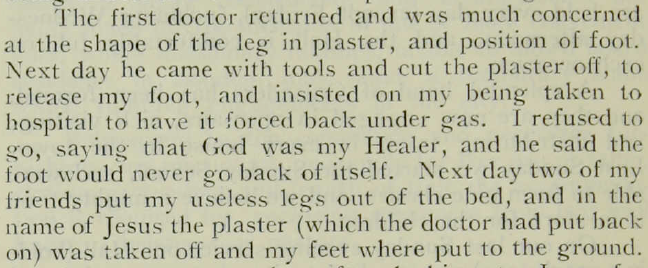
Two days later, while in prayer with a friend and seeking the Lord Jesus, the power of Almighty God went through her and her bones were re-set to His glory:

Three doctors and a nurse agreed that this was a work of God:
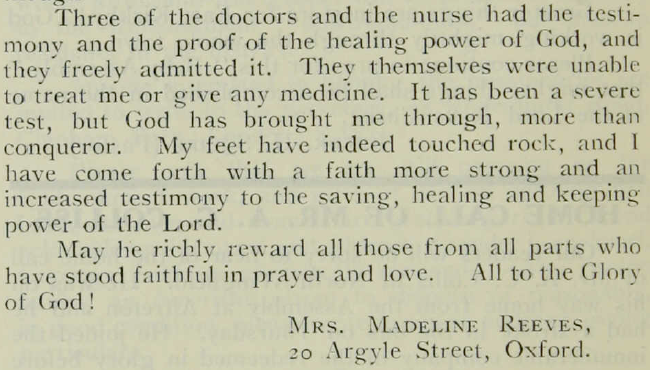
A healing testimony shared by L. Hayward of Chalfont Road in Redemption Tidings (1 August 1934, p. 12) shows that the assembly was meeting in an Emmanuel Hall by the end of 1933:
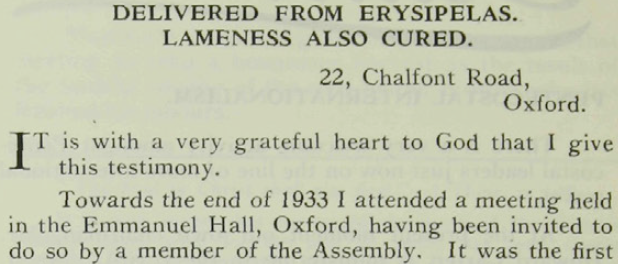
The presence of the Lord was tangible and by the next Sunday Hayward had been converted. Six weeks later he (or she, but my impression is that initial only generally signified a man) was baptised in the Holy Spirit:
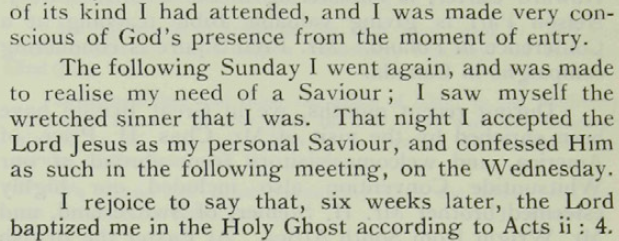
Shortly afterwards, he was stricken with erysipelas, a bacterial infection of the skin. Miss Weightman prayed for him in the Name of Jesus, and he was cured within half an hour, to the glory of God:
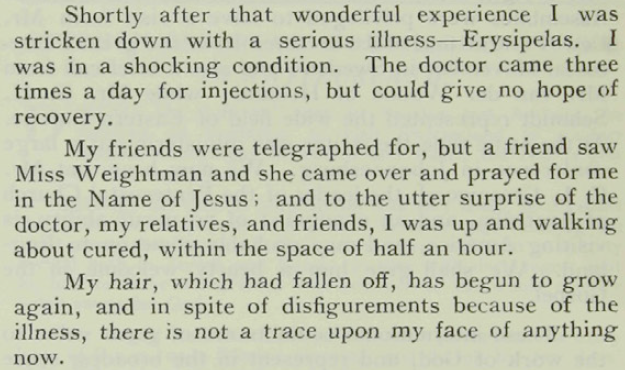
By the time of his letter, he had also been healed of lameness and was able to walk unaided, also to the glory of God:

By 1937, the assemblies were listed by location only (RT 1 January 1937, Cover IV):

The Redemption Tidings of 26 August 1938 contains (p. 8) an exhortation on the Name of Jesus by a David Newington of Oxford:

who became the pastor of the Prudhoe assembly in Northumberland in 1939 (RT 22 September 1939, p. 15). His father Arthur had joined a pentecostal church in 1909 and been baptised in the Holy Spirit in 1911. David was accepted as an AoG missionary to Tibet in 1941 but never reached there because of the war. He married Loreen in 1942, and they left for the Congo in 1945 where they served with the Congo Evangelistic Mission. He resigned from the mission in 1953 in order to start a work in Southern Rhodesia (now Zimbabwe) and at the same time transferred to the South African Assemblies of God. He ministered at the Brakpan Assembly near Johannesburg in the mid-1950s.
Miss Weightman submitted two testimonies to the 2 May 1941 issue of Redemption Tidings (p. 10), adding a third, of a 35 year old man with an abscess on his brain:
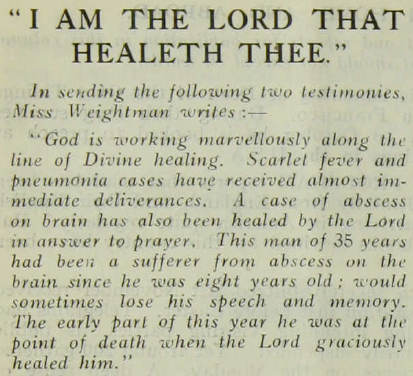
The daughter of a Jewish lady was healed of scarlet fever a few hours after Miss Weightman prayed for her in the Name of Jesus (F.W. will be Florence Weightman, see below):
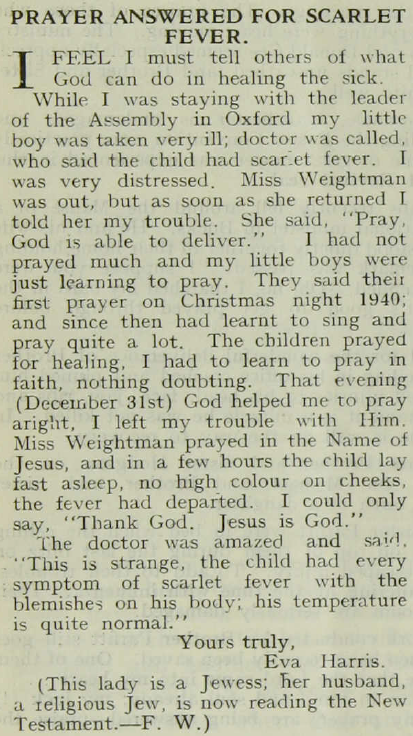
At the age of 17, Christian Haggett lay dying in hospital. While Christian was a relatively rare female name the reference to the gift of a soprano voice indicates that this was most probably a young woman. She recovered after the laying on of hands by Miss Weightman in the Name of Jesus, and was entertaining visitors and eating food the next day to the glory of God:
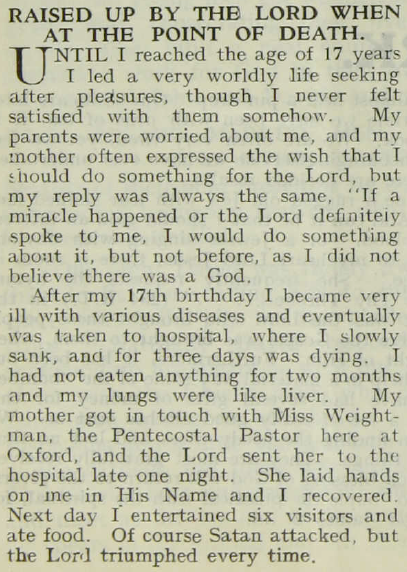

Reaching out to soldiers
One of the ‘assembly reports’ in Redemption Tidings 11 February 1944 (p. 8) concerned a ‘soldier’s rally’ in Oxford convened by C. Hallgate, a private from the Langold assembly in Nottinghamshire. Various soldiers ministered, in more than one service, and Miss Weightman with other workers provided refreshments. It was apparently the second of its type to be held there:

A third Soldier’s Rally was held (RT 16 February 1945) a year later on Sunday 4 February 1945. The services were distinguished by a sense of the presence of God in their midst. Hallelujah, has the Lord Jesus not promised that He will be with us when we gather in His holy Name (Matthew 18:20)?!

We learn from this short report that the assembly was by still meeting in Emmanuel Hall, and that it was on the Cowley Road.
Reach them now!
Redemption Tidings 23 May 1947 carried an exhortation to make use of the short window of opportunity to reach the German prisoners of war before they were returned to their home country:
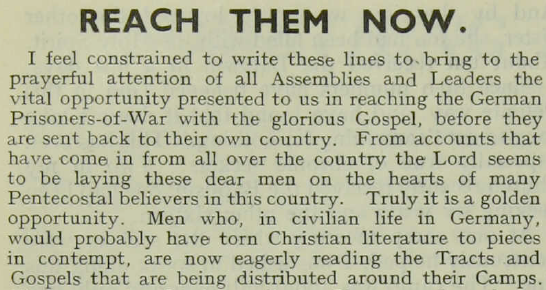
34 Germans were to attend a meeting at the assembly hall in Oxford, with refreshments :

This loving gospel outreach to men that had been fighting on the other side of a long and bitter war brings to a fitting end the history of the first phase of the Oxford pentecostal church (Assemblies of God), so far as I have been able glean it from the pages of Redemption Tidings. All that remains is to tell of its probable end.
Miss Weightman resigns and joins Elim
Miss Weightman, whose first name we now learn was Florence, went to be with the Lord on 22 January 1969, aged 81. The notice (p. 136) in the Elim Evangel of 22 February 1969:

informs us that she had continued to lead the assembly until the Elim church was planted in 1953, whereupon she resigned her position and joined the new church, continuing as a faithful member of it until her passing. As I recounted in my last article, the Elim church was formed in May 1953, and had moved into its own building in Botley Road by October 1953, to the glory of God. Florence Weightman had become the presbyter of the Oxford assembly by June 1928 (see above), so it would seem that she led it for twenty-five years. It could possibly be relevant that she moved house in 1953 (RT 23 October 1953, p. 7):

Conceivably (for example), she had been living in church accommodation and the assembly closed down when she resigned and joined Elim. It is clear from the testimonies that she was mightily used in healing the sick in Jesus’ mighty and holy Name. We also find her giving hospitality to the Jewish lady, Eva Harris, and to soldiers away from home.
I thank God for all those who have laboured in Oxford over the centuries, and over the last hundred years or so in particular. To God be all the glory for the harvest that has been reaped through His faithful servants. May we be inspired by their endeavours and press forward to do greater things in His wonderful and glorious Name, the Name of the Lord Jesus Christ.